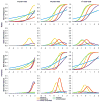Modeling the impact of age and sex on a dimension of poly-substance use in adolescence: a longitudinal study from 11- to 17-years-old
- PMID: 20456876
- PMCID: PMC2905476
- DOI: 10.1016/j.drugalcdep.2010.01.023
Modeling the impact of age and sex on a dimension of poly-substance use in adolescence: a longitudinal study from 11- to 17-years-old
Abstract
We examined the conceptual utility of modeling use of multiple substances as a trait represented by a unified dimension throughout adolescence. Adolescents (710 males and 676 females) participating in a longitudinal community study were asked whether they had used alcohol, tobacco, marijuana, other controlled substances, or uncontrolled substances (i.e. over-the-counter medications and inhalants) at ages 11, 14, and 17. Using an item response theory framework, model fit indices demonstrated that although all substance use remained part of a single latent dimension, model parameters differed with age and according to sex. The impact of sex was observed at the level of the overall dimension, with reported substance use generally indicating a higher trait level (i.e. greater severity) in females than in males. While using these substances provided good information on individual trait level in mid- to late-adolescence, the trait was poorly characterized by substance use in early adolescence. Across ages and sexes, use of alcohol and tobacco tended to indicate lower trait levels than use of marijuana, other controlled substances, and uncontrolled substances. All substances provided a similar amount of information on the underlying dimension (except for uncontrolled substances, which provided the least information). This suggests that measurement and interpretation of adolescent substance use is enhanced by the consideration of a wide range of substances.
Copyright (c) 2010 Elsevier Ireland Ltd. All rights reserved.
Conflict of interest statement
All authors declare that they have no conflicts of interest.
Figures


References
-
- Alterman AI, Cacciola JS, Habing B, Lynch KG. Addiction Severity Index recent and lifetime summary indexes based on nonparametric item response theory methods. Psychol Assess. 2007;19:119–132. - PubMed
-
- Embretson SE, Reise SP. Item response theory for psychologists. Lawrence Erlbaum Associates; Mahwah NJ: 2000.
-
- Gillespie NA, Neale MC, Prescott CA, Aggen SH, Kendler KS. Factor and item-response analysis of DSM-IV criteria for abuse of and dependence on cannabis, cocaine, hallucinogens, sedatives, stimulants and opioids. Addiction. 2007;102:920–930. - PubMed
-
- Hall WD, Lynskey M. Is cannabis a gateway drug? Testing hypotheses about the relationship between cannabis use and the use of other illicit drugs. Drug Alcohol Rev. 2005;24:39–48. - PubMed

